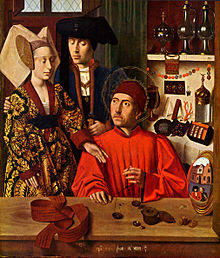St Eligius
| Saint Eligius | |
|---|---|

The Legend of Saint Eligius and Saint Godeberta, by Petrus Christus.
|
|
| Bishop and Confessor | |
| Born | c. 588 Chaptelat, Limoges, Aquitaine (modern-day France) |
| Died | 1 December 660 Noyon, France |
| Venerated in |
Roman Catholic Church Eastern Orthodox Church |
| Canonized | Pre-Congregation |
| Feast | 1 December |
| Attributes | Anvil; Bishop with a crosier in his right hand, on the open palm of his left a miniature church of chased gold; bishop with a hammer, anvil, and horseshoe; bishop with a horse; courtier; goldsmith; hammer; holding a horse's leg, which he detached from the horse in order to shoe it more easily; horseshoe; man grasping a devil's nose with pincers; man holding a chalice and goldsmith's hammer; man shoeing a horse; man with hammer and crown near a smithy; man with hammer, anvil, and Saint Anthony; pincers; with Saint Godeberta; giving a ring to Saint Godeberta; working as a goldsmith |
| Patronage | cartwrights; clock/watch makers; coin collectors; craftsmen of all kinds; cutlers; gilders; goldsmiths; harness makers; horses; jewelers; jockeys; knife makers; laborers; locksmiths; metalworkers in general; miners; minters; Royal Electrical and Mechanical Engineers; Royal Australian Electrical and Mechanical Engineers; saddlers; tool makers; veterinarians |
Saint Eligius (also Eloy or Loye) (French: Éloi) (c. 588 – 1 December 660) is the patron saint of goldsmiths, other metalworkers, and coin collectors. He is also the patron saint of veterinarians, the Royal Electrical and Mechanical Engineers (REME), a corps of the British Army, but he is best known for being the patron saint of horses and those who work with them. Eligius was chief counsellor to Dagobert I, Merovingian king of France. Appointed the bishop of Noyon-Tournai three years after the king's death in 642, Eligius worked for twenty years to convert the pagan population of Flanders to Christianity.
Eligius was born at the "villa" of Chaptelat, six miles north of Limoges, in Aquitaine (now France), into an educated and influential Gallo-Roman family. His father, recognizing unusual talent in his son, sent him to the goldsmith Abbo, master of the mint at Limoges. Later Eligius went to Neustria, the palace of the Franks, where he worked under Babo, the royal treasurer, on whose recommendation Clotaire II, king of the Franks, is said to have commissioned him to make a throne of gold adorned with precious stones.
St. Eligius is the Patron Saint of the Royal Electrical and Mechanical Engineers.
Among other goldsmith's work soon entrusted to Eligius were the bas-reliefs for the tomb of Saint Germain, Bishop of Paris. Clotaire took Eligius into the royal household and appointed him master of the mint at Marseilles.
...
Wikipedia
